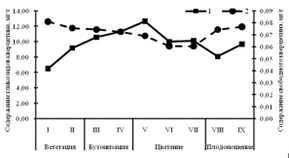PHENOLIC COMPOUNDS DASIPHORA DAVURICA DEPENDING ON THE PHASE DEVELOPMENT
UDC 577.13:582.711.71:571.61
Abstract
Results of seasonal changes of phenolic compounds are presented in the article for leaves of Dasiphora davurica grown in culture of the south of the Amur region. The phenolic compounds were analyzed by the method of a high-performance liquid chromatography. Five glycosides of flavonol (hyperoside, isoquercitrin, rutin, avicularin, quercitrin), one aglycone (quercetin) and tannins (ellagic acid and its glycoside) were found. It was found that phenolic composition of D. davurica is constant, but the changes of qualitative composition occur at the expense of minor compounds. The largest number of phenolic components (21) was established in stage the period of full isolation of leaves and periods of mass and the ending of a blossoming. A higher total content of phenolic compounds in leaves of D. davurica was established in the stages of mass budding (24,3 mg/g). A higher of total flavonols was found in the stages of formation of the first flowers (15,2 mg/g). Quercetin, kaempferol, rhamnetin glycosides were found in all stages of development. The largest glycosides of flavonols was found in the phase of the budding, in the stage of the beginning and mass blossoming with aglycones (quercetin) at the beginning of vegetation and the ending of a blossoming. A fact of contrariety of the dynamics of accumulation of glycosides and their aglycones was revealed. A higher content of most individual phenolic compounds was found in mature leaves in the flowering and fruiting phases. Avicularin is the predominant glycoside during the growing season. Ellagic acid dominated in mature tissues whereas ellagic acid glycoside was the predominant in young leaves.
Downloads
Metrics
References
Komarov V.L., Klobukova-Alisova Ye.N. Opredelitel' rasteniy Dal'nevostochnogo kraya. [Key to plants of the Far Eastern Territory]. Leningrad, 1932, 1175 p. (in Russ.).
Kurbatskiy V.I. Flora Sibiri. [Flora of Siberia]. Novosibirsk, 1988, vol. 8, pp. 36–38. (in Russ.).
Cherepanov S.K. Sosudistyye rasteniya Rossii i sopredel'nykh gosudarstv (v predelakh byvshego SSSR). [Vascular plants of Russia and neighboring states (within the former USSR)]. St. Petersburg, 1995, 992 p. (in Russ.).
Konspekt flory Aziatskoy Rossii: Sosudistyye rasteniya [Synopsis of the flora of Asiatic Russia: Vascular plants], ed. K.S. Baykov. Novosibirsk, 2012, 640 p. (in Russ.).
Sokolov S.Ya., Svyazeva O.A., Kublin V.A., Sokolova Yu.D., Musayeva I.F., Lovelius O.L. Arealy derev'yev i kustarnikov SSSR. [Areas of trees and shrubs of the USSR]. Leningrad, 1980, vol. 2, 144 p. (in Russ.).
Lingdi L., Cuizhi G., Chaoluan L., Alexander C., Bartholomew B., Brach A.R., Boufford D.E., Ikeda H., Ohba H., Robertson K.R., Spongberg S.A. Flora of China (Rosaceae). Science Press, Beijing, and Missouri Botanical Garden Press, St. Louis., 2003, vol. 9, pp. 46–434.
Koropachinskiy I.Yu., Vstovskaya T.N. Drevesnyye rasteniya Aziatskoy Rossii. [Woody plants of Asiatic Russia]. Novosibirsk, 2002, 707 p. (in Russ.).
Khramova Ye.P., Andysheva Ye.V. Rastitel'nyy mir Aziatskoy Rossii, 2014, no. 2, pp. 65–70. (in Russ.).
Andysheva E.V., Khramova E.P. Botanica Pacifica, 2020, vol. 9, no. 1, pp. 77–83. DOI: 10.17581/bp.2020.09103.
Khramova E.P. Turczaninowia, 2013, vol. 16, no. 4, pp. 55–62. DOI: 10.14258/turczaninowia.16.4.10. (in Russ.).
Minayeva V.G. Flavonoidy v ontogeneze rasteniy i ikh prakticheskoye ispol'zovaniye. [Flavonoids in plant ontogenesis and their practical use]. Novosibirsk, 1978, 253 p. (in Russ.).
Chaves N., Escudero J.C., Gutierres-Merino C. Journal of Chemical Ecology, 1997, vol. 23, no. 3, pp. 579–603.
Riipi M., Ossipov V., Lempa K., Haukioja E., Koricheva J., Ossipova S., Pihlaja K. Oecologia, 2002, vol. 130, no. 3, pp. 380–390.
Berini J.L., Brockman S.A., Hegeman A.D., Reich P.B., Muthukrishnan R., Montgomery R.A., Forester J.D. Fron-tiers in Plant Science, 2018, vol. 9, 1257. DOI: 10.3389/fpls.2018.01257.
Liu W., Wang D., Hou X., Yang Y, Xue X., Jia Q., Zhang L., Zhao W., Yin D. Chemistry and Biodiversity, 2018, vol. 15, no. 7, e1800114. DOI: 10.1002/cbdv.201800114.
Yang L., Wen K.S., Ruan X., Zhao Y.X, Wei F., Wang Q. Molecules, 2018, vol. 23, 762. DOI: 10.3390/molecules23040762.
Isah T. Biological Research, 2019, vol. 52, 39. DOI: 10.1186/s40659-019-0246-3.
Yermakov A.I., Arasimovich V.V., Yarosh N.P. Metody biokhimicheskogo issledovaniya rasteniy. 3-ye izd. [Methods of biochemical research of plants. 3rd ed.]. Leningrad, 1987, 430 p. (in Russ.).
Van Beek T.A. Journal of Chromatography A, 2002, vol. 967, no. 1, pp. 21–55. DOI: 10.1016/S0021-9673(02)00172-3.
Yur'yev D.V., Eller K.I., Arzamastsev A.P. Farmatsiya, 2003, no. 2, pp. 7–10. (in Russ.).

Copyright (c) 2022 chemistry of plant raw material

This work is licensed under a Creative Commons Attribution 4.0 International License.

This work is licensed under a Creative Commons Attribution 4.0 International License.
The authors, which are published in this journal, agree to the following conditions:
1. Authors retain the copyright to the work and transfer to the journal the right of the first publication along with the work, at the same time licensing it under the terms of the Creative Commons Attribution License, which allows others to distribute this work with the obligatory indication of the authorship of this work and a link to the original publication in this journal .
2. The authors retain the right to enter into separate, additional contractual agreements for the non-exclusive distribution of the version of the work published by this journal (for example, to place it in the university depository or to publish it in a book), with reference to the original publication in this journal.
3. Authors are allowed to post their work on the Internet (for example, in a university repository or on their personal website) before and during the review process of this journal, as this may lead to a productive discussion, as well as more links to this published work.











